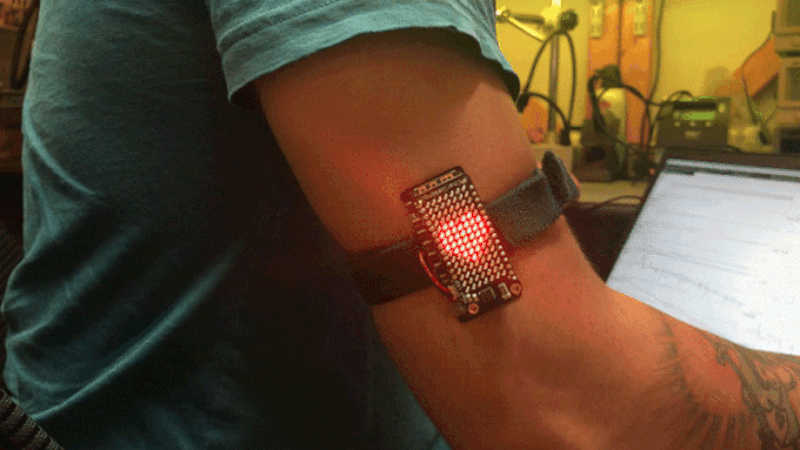There are a few different ways to take a person’s pulse, with varying utility depending on the categories said patient fits in to. [Nitin Nair]’s method doesn’t really have a medical application, but it’s certainly a neat example of what you can do with modern sensors.
The build combines an EmotiBit sensor platform with an Adafruit Feather and accompanying Charlieplexed LED module. The EmotiBit packs a PPG, or photoplethysmogram sensor, otherwise known as a pulse oximeter, which uses optical methods to detect changes in blood volume beneath the skin. From this data, a pulse rate can be derived, and the LEDs flashed with a heart graphic in concert with the rhythm of the wearer’s heart. The benefit of the PPG in the EmotiBit is that it can be worn on the wearer’s arm, or other location with suitable vascularization. This allows the wearer to place the sensor on the arm, and thus wear their heart on their sleeve.
It’s a cool concept, and we’d love to see it neatly packaged with a smoothly animated fade as a sports accessory. It’d be an easy way to signal how fast your heart rate recovers on a run with friends – the device could brag about your fitness for you. Alternatively, if pulse oximetry isn’t enough for you, go ahead and build an ECG instead!
















At the children’s museum here there is an exhibit that is some sort of bespoke circuit to count your pulse if you put one hand each on a couple of electrodes (brass cylinders on a durable handle). It is some sort of ECG. I’m not sure if it’s individual variation, aging of the circuit, or aging of the electrodes, but it never works. It gets a very unsteady pulse, sometimes double-counting, and sometimes missing an extended sequence of beats.
From my own games with sampling sensors, I imagine that it is a very difficult problem to produce a stutter-free canonical on / off value from most sensors. And, in fact, sometimes the data can only be understood in retrospect…what was ambiguously an upward pulse becomes obviously a peak only after the subsequent valley is recorded.
Since this device has such a capable display, I’d love it if it could give a display conveying some greater sense of nuance so that great pattern recognizer / hat rack can read the data, and can tell intuitively if it’s quality data or not.
OTOH in this animation it’s clearly working perfectly. :)
Wearing your heart on your sleeve, I see what you did there.
I made a chest-worn version with a bright RGB LED a few years ago. The light is pulsed with the heartbeat and color-coded according to predefined heart rate ranges. You can check out the failed Kickstarter for pictures and videos of it:
https://www.kickstarter.com/projects/804820373/cardiglow-a-sixth-sense-for-your-heart
I really like the bio-feedback the concept provides. Running through a forest that pulses with your heart is an amazing meditative experience. If you have a mirror in front of you (in a gym/course) or if it is only the trainer and/or other team members that need to see how exhausted you are then it works fine under bright light conditions. There are probably a lot of interesting dynamics that could emerge if you use it with multiple people (e.g. pass the ball to the least exhausted). Maybe the battery-hungry continuous light mode without pulses is better then, because pulses with different rates could become annoying.
The PoC shown in one of the pictures is just a mega8 decoding data from a Polar strap with an inductor. Further iterations were based on Blue Gecko modules and a simple amplifier for the ECG signal. Nowadays I would rather use an Apollo3 Blue module (aka SparkFun Artemis). LEDs are driven by a SIMO converter, providing multiple hours of runtime from a 700mAh(-ish?) battery. The strap is off-the-shelf and you can use some YKK press-buttons soldered to a board to connect to it.